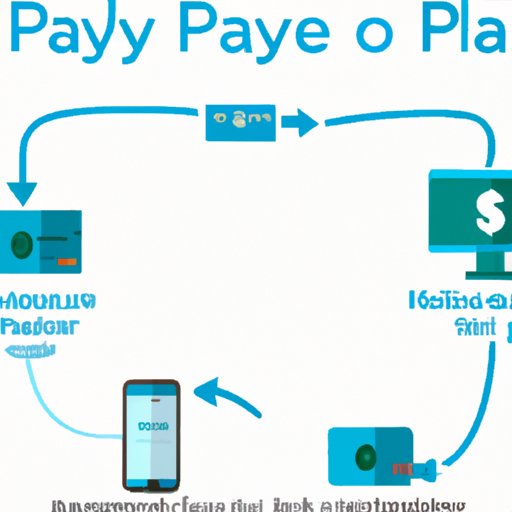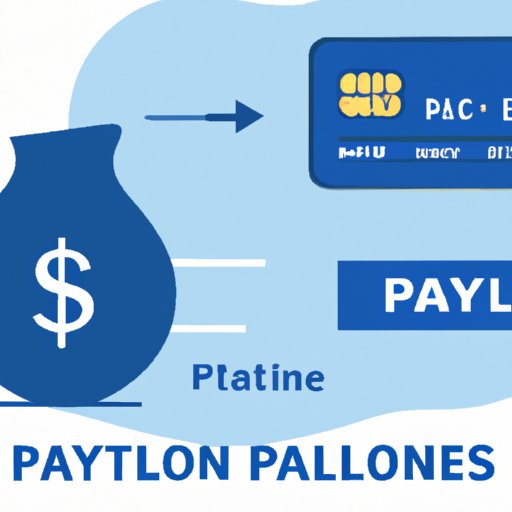Introduction
PayPal is an American company that operates as an online payments system. It allows users to send and receive money electronically via their computers or mobile devices. The service is available in 203 markets, and supports 25 currencies.
The purpose of this article is to provide a comprehensive guide to understanding how does PayPal work when sending money. We will cover topics such as creating a PayPal account, linking your bank account and/or credit card to your PayPal account, entering payment amount and recipient information, confirming payment details, completing payment, exploring the benefits of using PayPal for money transfers, the authorization, clearing and settlement process, payment types, fees, transaction limits, country restrictions, and more.
Step-by-Step Guide to Sending Money via PayPal
Sending money through PayPal is easy and secure. Here is a step-by-step guide to help you get started:
Creating a PayPal Account
To send money through PayPal, you first need to create a PayPal account. This is free and easy to do. All you need to do is provide your email address, name, address, and phone number. You will then be asked to create a password and select a security question.
Linking Your Bank Account and/or Credit Card to Your PayPal Account
Once you have created your account, you will need to link it to a bank account or credit card. This is necessary if you want to send money from your PayPal account. To link your accounts, simply follow the instructions on the PayPal website.
Entering Payment Amount and Recipient Information
Once your accounts are linked, you can start sending money. To do this, you will need to enter the payment amount and the recipient’s information. This includes their name, email address, and phone number (if applicable). Once you have entered the information, you can review the payment details before sending.
Confirming Payment Details
Before sending the money, you will need to confirm the payment details. This includes checking the recipient’s information and the payment amount. If everything is correct, you can click “send” to complete the transaction.
Completing Payment
Once you have confirmed the payment details and clicked “send”, the payment will be processed. Depending on the recipient’s payment method, the money may be available instantly or it may take a few days to arrive.

Exploring the Benefits of Using PayPal for Money Transfers
There are many benefits to using PayPal for money transfers. These include convenience, security, low fees, and instant access.
Convenience
One of the biggest advantages of using PayPal for money transfers is the convenience it offers. You can send money anywhere in the world in just a few clicks. Plus, you don’t have to worry about carrying cash or waiting in line at a bank or other financial institution.
Security
PayPal is highly secure, which makes it a great option for sending money. Your personal and financial information is protected by advanced encryption technology, and all transactions are monitored 24/7 to prevent fraud and identity theft.
Low Fees
PayPal also offers low fees compared to other money transfer services. The exact fee depends on the payment type and the country where the money is being sent. However, the fees are usually much lower than those charged by banks or other financial institutions.
Instant Access
With PayPal, you can send money almost instantly. This means that you can send money to someone in another country and they can have access to it within minutes. This is especially useful for emergency situations or when you need to send money quickly.

An Overview of How PayPal Works for Money Transfer
When you use PayPal to send money, there are three main steps involved: authorization, clearing, and settlement. Here is an overview of each step:
Authorization Process
The authorization process is the first step in sending money with PayPal. During this step, PayPal verifies that you have enough funds in your account to make the payment. If there are sufficient funds, the payment is authorized and the money is deducted from your account.
Clearing Process
The clearing process is the second step in sending money with PayPal. During this step, PayPal sends the money to the recipient’s bank account. Depending on the recipient’s bank, this process can take up to two business days.
Settlement Process
The settlement process is the final step in sending money with PayPal. During this step, the recipient’s bank deposits the money into their account. This process can also take up to two business days.

A Complete Guide to Sending Funds with PayPal
When sending funds with PayPal, there are several things you should consider. Here is a complete guide to help you get started:
Choosing a Payment Type
When sending money through PayPal, you have several payment options. You can choose to pay with your bank account, credit card, debit card, or PayPal balance. Each option has its own pros and cons, so it is important to choose the right one for your needs.
Understanding Fees
PayPal charges fees for every transaction. The exact fee depends on the payment type and the country where the money is being sent. It is important to understand these fees before sending money, as they can add up quickly.
Setting Up Automatic Payments
PayPal also offers the option to set up automatic payments. With this feature, you can schedule recurring payments without having to log into your account every time. This is especially useful for bills or other regular payments.
What You Need to Know about Sending Money through PayPal
Before sending money through PayPal, there are a few things you should know. These include limitations on account types, transaction limits, and country restrictions.
Limitations on Account Types
PayPal only allows certain types of accounts to send and receive money. For example, some countries only allow personal accounts to send money, while others require business accounts. It is important to check the requirements in your country before sending money.
Transaction Limits
PayPal also has transaction limits for both sending and receiving money. These limits vary depending on the type of account and the country where the money is being sent. It is important to check the limits before sending money.
Country Restrictions
Finally, PayPal has restrictions on which countries it can send money to. Some countries are not supported, so it is important to check the list of supported countries before sending money.
A Beginner’s Guide to Sending Money with PayPal
If you’re new to PayPal, here is a beginner’s guide to help you get started:
Setting up Your Account
The first step is to create a PayPal account. This is free and easy to do. Simply provide your email address, name, address, and phone number. You will then be asked to create a password and select a security question.
Understanding the Fees
It is important to understand the fees associated with sending money through PayPal. The exact fee depends on the payment type and the country where the money is being sent. Make sure to check the fees before sending money.
Sending Money
Once your account is set up, you can start sending money. To do this, you will need to enter the payment amount and the recipient’s information. This includes their name, email address, and phone number (if applicable). Once you have entered the information, you can review the payment details before sending.
Receiving Money
PayPal also allows you to receive money. To do this, you will need to provide the sender with your PayPal email address. Once the sender has sent the money, it will appear in your PayPal account.
Conclusion
In conclusion, sending money through PayPal is easy and secure. By following the steps outlined in this article, you can easily send money to anyone in the world in just a few clicks. Plus, you don’t have to worry about carrying cash or waiting in line at a bank or other financial institution. So what are you waiting for? Get started today!
Summary of the Article
This article provided a comprehensive guide to understanding how does PayPal work when sending money. We covered topics such as creating a PayPal account, linking your bank account and/or credit card to your PayPal account, entering payment amount and recipient information, confirming payment details, completing payment, exploring the benefits of using PayPal for money transfers, the authorization, clearing and settlement process, payment types, fees, transaction limits, country restrictions, and more.
Final Thoughts
PayPal is one of the most popular and secure ways to send money. With its low fees, convenience, and security, it is no wonder why so many people rely on this service for their money transfers. Now that you know how does PayPal work when sending money, you can start using it with confidence.
(Note: Is this article not meeting your expectations? Do you have knowledge or insights to share? Unlock new opportunities and expand your reach by joining our authors team. Click Registration to join us and share your expertise with our readers.)
